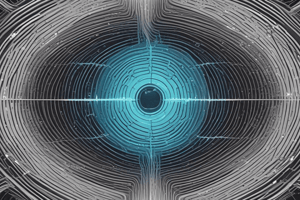Podcast
Questions and Answers
What is the reason behind the magnetic effect?
What is the reason behind the magnetic effect?
- Nuclear fusion
- Gravitational force
- Electric charge (correct)
- Infrared radiation
How does the strength of a magnetic field change with distance?
How does the strength of a magnetic field change with distance?
- Varies inversely with the square of the distance (correct)
- Remains constant
- Decreases exponentially
- Increases linearly
In which material does the magnetic effect occur most strongly?
In which material does the magnetic effect occur most strongly?
- Copper
- Wood
- Iron (correct)
- Plastic
What is a direct combination reaction, also known as a synthesis reaction?
What is a direct combination reaction, also known as a synthesis reaction?
Which of the following represents a combination reaction?
Which of the following represents a combination reaction?
Why are combination reactions usually exothermic?
Why are combination reactions usually exothermic?
What happens when barium metal and fluorine gas combine?
What happens when barium metal and fluorine gas combine?
What is the product when magnesium oxide combines with carbon dioxide?
What is the product when magnesium oxide combines with carbon dioxide?
Which type of reaction involves the formation of a single compound from two or more reactants?
Which type of reaction involves the formation of a single compound from two or more reactants?
What type of reaction occurs when a metal combines with a non-metal?
What type of reaction occurs when a metal combines with a non-metal?
What is the product of the reaction between lithium and sulfur?
What is the product of the reaction between lithium and sulfur?
What is formed when magnesium burns in air?
What is formed when magnesium burns in air?
Why is elemental oxygen (O) not used in the formation of Iron (III) Oxide?
Why is elemental oxygen (O) not used in the formation of Iron (III) Oxide?
Which type of combination reaction involves two elements?
Which type of combination reaction involves two elements?
What is the product of the reaction between calcium oxide and water?
What is the product of the reaction between calcium oxide and water?
What type of reaction occurs when iron combines with sulfur?
What type of reaction occurs when iron combines with sulfur?
What is the result of hydrogen reacting with chlorine?
What is the result of hydrogen reacting with chlorine?
What are the products of the combustion of hydrogen?
What are the products of the combustion of hydrogen?
Why is elemental oxygen not commonly used in chemical reactions under natural conditions?
Why is elemental oxygen not commonly used in chemical reactions under natural conditions?
Flashcards are hidden until you start studying
Study Notes
Magnetic Effect
- The magnetic effect occurs due to the presence of magnetic fields, which are strongest in ferromagnetic materials such as iron, nickel, and cobalt.
- The strength of a magnetic field decreases with distance, following the inverse square law.
Chemical Reactions
- A direct combination reaction, also known as a synthesis reaction, is a type of reaction where two or more reactants combine to form a single product.
- Examples of combination reactions include:
- Barium metal (Ba) + Fluorine gas (F2) → Barium fluoride (BaF2)
- Magnesium oxide (MgO) + Carbon dioxide (CO2) → Magnesium carbonate (MgCO3)
- Combination reactions are usually exothermic, meaning they release heat energy.
- Types of combination reactions include:
- Elemental combination reactions, where two elements combine to form a compound (e.g., Lithium + Sulfur → Lithium sulfide)
- Metal-nonmetal combination reactions, where a metal combines with a non-metal (e.g., Iron + Sulfur → Iron(II) sulfide)
- When magnesium burns in air, it forms magnesium oxide (MgO).
- Elemental oxygen (O) is not commonly used in chemical reactions under natural conditions due to its reactive nature.
- Iron(III) oxide is formed through the reaction of iron with oxygen, not elemental oxygen.
- Calcium oxide (CaO) reacts with water (H2O) to form calcium hydroxide (Ca(OH)2).
- Iron combines with sulfur to form Iron(II) sulfide (FeS).
- Hydrogen reacts with chlorine to form hydrogen chloride (HCl).
- The products of the combustion of hydrogen are water (H2O) and heat energy.
Studying That Suits You
Use AI to generate personalized quizzes and flashcards to suit your learning preferences.




